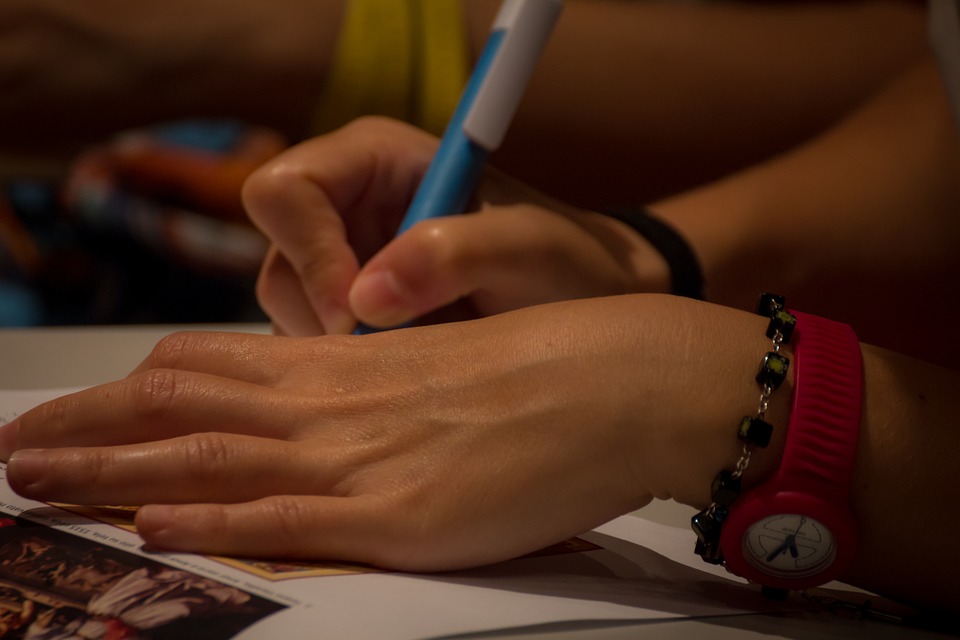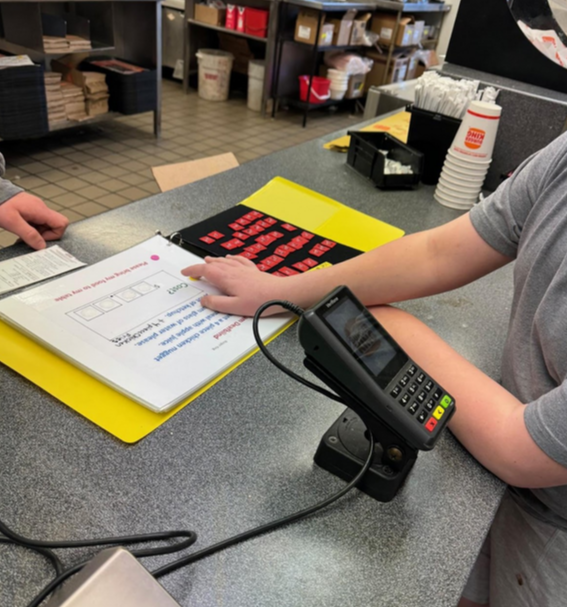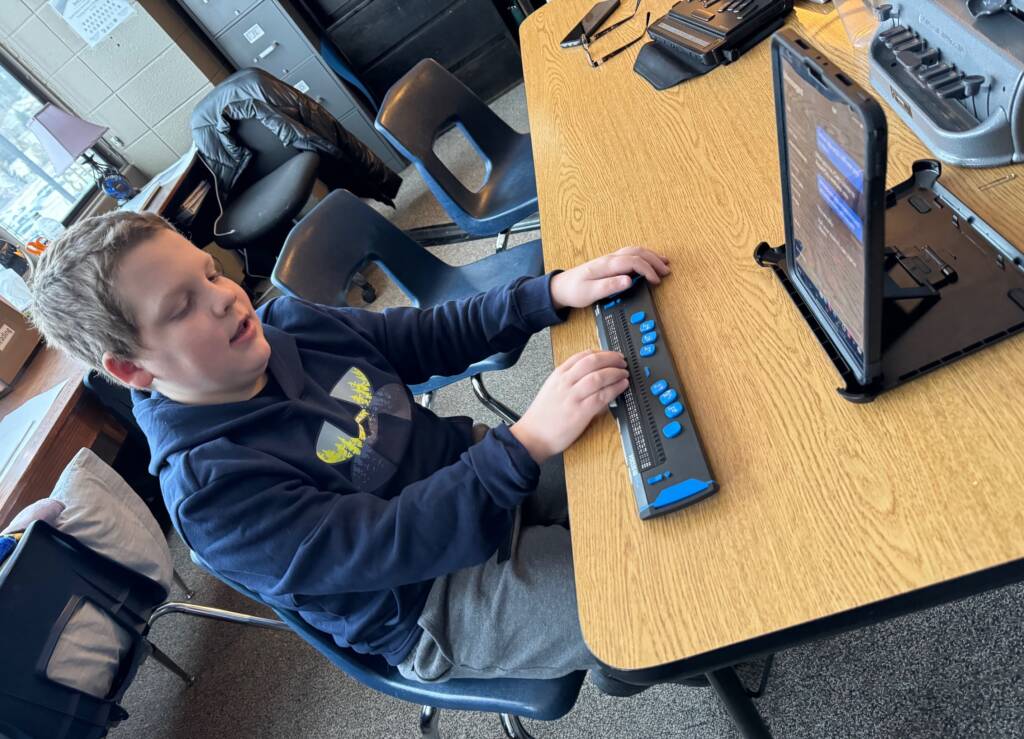 Lire en français.
Lire en français.
School is one of the most important factors in the life of a child. It is the source of many of their feelings of self-esteem and competence as a person separate from their family. Not surprisingly, difficulties at school often result in feelings of low self-esteem and discomfort in many different environments. Students tend to cope with these feelings in different ways. Some students develop coping strategies that allow them to effectively deal with difficulties in school. Other children develop less effective coping strategies including noncompliant and uncooperative behaviors. For another group of students, worry and anxiety become feelings that accompany them throughout their school day.
Anxiety and Visual Impairment
Anxiety is the most common emotional difficulty that is experienced by adults as well as children. The National Association of School Psychologists (NASP) indicates that between 2-27% of students in our schools have significant difficulties with anxiety. In my experience, students with visual impairment are especially prone to have problems with anxiety. Much of their world is unpredictable without the assistance of adequate visual information. For students who are also struggling with some type of learning difficulties, these problems can be magnified. Children who struggle in school often develop a concept of themselves as being ineffective with one of their major life tasks. These concerns can easily lead to significant anxiety when in school settings. Without intervention, this condition can cause additional difficulties in school that result in increased likelihood of dropping out of school as well as under/unemployment as an adult.
Parents and teachers alike know that there are significant differences in the ways that children view the world, and that these differences often seem present at birth. Children seem to be born with a tendency to look at the world either as a positive and supportive environment or as an environment that is more threatening and troublesome. These differences are seen early with children that are welcoming to strangers, less concerned by change, and easier to comfort. Environment can have an effect upon these tendencies, but much of our research continues to support that much of this is inborn. Some children are simply born more anxious, and this trait continues throughout much of their life.
No teacher would be expected to be able to identify a student who has an anxiety disorder, but it is helpful to be able to recognize some of the different types of anxiety as well as strategies that are effective in the classroom. It is very likely that a TVI will encounter multiple children during their career who have a type of anxiety. The likelihood is magnified for students who are dealing with both a visual impairment as well as a learning disability. To gain assistance with these behaviors, it will be important for the teacher to be able to observe and describe behaviors of concern. In addition, specific strategies listed below will help the TVI to provide a more supportive environment. In this way, the student can become a better learner. Additionally, in many cases, it allows the student to demonstrate what they already know without fear of failure.
How do worried students and anxious students differ?

Both of these conditions involve emotional distress. Both of them involve a student having a concern that they cannot control or succeed at some event in their future. Both can have a negative effect upon the student’s ability to learn or to demonstrate a particular skill. However, worry tends to be a less intense emotional state, and often is limited to a single situation. For example, students may worry about a single test when they know the topic is difficult. Anxiety is a more overriding concern, and involves physical sensation. The autonomic nervous system (system that regulates internal body functions) is typically involved. The student who is dealing with anxiety may feel symptoms such as a rapid heartbeat when asked to do things that provoke anxious responses. As with the previous example, the anxious student is concerned about all tests. Regardless of the topic or her level of mastery of the materials, the anxious student is certain of her own failure.
I know that there are different types of anxiety for adults. Is this the case for students with VI and LD?
There are many different types of anxiety. Typically psychologists will refer to these as anxiety disorders. The anxiety disorder most frequently encountered is Generalized Anxiety Disorder.
What behaviors are associated with Generalized Anxiety Disorder?
There are a wide number of behaviors that are associated with this condition. Unfortunately teachers frequently see these behaviors as indicators of excessive dependence rather than those of an anxious student. It is important to try to observe more closely to determine antecedents prior to making a decision about the cause for the behaviors. As always, the presence of one or two behaviors may not be significant. However, multiple behaviors should always be considered as possible indicators. The list of behaviors includes the following:
-
Wants to do tasks perfectly or not at all
-
Excessively eager for approval or reassurance from adults
-
High levels of self-criticism
-
Repeated seeking of help to avoid mistakes
-
May appear shy but often preoccupied with worries
-
Many somatic complaints such as stomachaches and headaches
-
Resistance to attempting new or challenging activities
-
Difficulty with transitioning to new activities or environments
-
Irritability when preoccupied with worries
-
Repetitive rituals or routines that seem to have no purpose
-
Inability to explain behaviors that may be of concern to others
-
Physical symptoms such as hyperventilating for no apparent reason
-
Tics or nervous mannerisms such as nail-biting
-
Negative view of possible outcomes of behavior and/or efforts
 The parents keep talking about anxiety, but I see a great deal of non-compliance. How do I tell the difference?
The parents keep talking about anxiety, but I see a great deal of non-compliance. How do I tell the difference?
Sometimes it is difficult to tell the difference. Sometimes behaviors that are troublesome are a combination of the two. Most of us will try a number of different strategies to avoid doing something that is troubling. As adults, we simply have more options for avoidance than students. The best way to tell the difference is to have some actual data that records when the student is engaging in the behaviors. You need to know when the behaviors are occurring and what the outcome of the behaviors is. It is always helpful to have some formal evaluation from a psychologist or a counselor to explore these issues. Probably the biggest mistake is to assume that the behavior is simply the result of non-compliance or lack of motivation. Those assumptions should be saved as a conclusion only after other issues have been explored.
Are there particular situations that tend to make anxiety worse for students?
There is a wide variation in what can make an individual student anxious. However, the following situations are those that typically will cause higher levels of anxiety:
-
Asking student to engage in unfamiliar and/or challenging task
-
Requiring participation in large group activities that involve others judging performance
-
Providing direct criticism, particularly in front of others
-
Placing student in environment where expectations are not clear
-
Abruptly withdrawing expected level of support from adults
-
Reminding student that there is “nothing to worry about”
How can I help a student who seems to be dealing with anxiety?
One of the most important things that a TVI or a parent can do is to provide good observation to help develop a plan to help the student. A comprehensive plan for decreasing anxiety will need a Multidisciplinary Team (MDT) approach. There will be students who are exhibiting mild forms of an anxiety disorder that can be helped by implementing classroom strategies. Other students may require a formal evaluation with specific recommendations to guide classroom strategies as well as therapies.
Some classroom strategies that have been helpful in the past include:
-
Introduce new and challenging tasks in a gradual manner
-
Provide opportunities to self-grade/correct work
-
Avoid providing correction in front of others
-
Try to provide feedback on what was done correctly as well as what is incorrect
-
Give student prior knowledge about specific tasks that must be completed in front of the class
-
Pair with supportive and socially-competent peers
-
Develop signal that student can use to request help
-
Help student develop ways that they can calm themselves while in the classroom, for example taking a brief break to get a drink of water
-
Consult with counselor for suggestions about relaxation techniques that the student might be able to use in the classroom
-
Consult with counselor for ways that Cognitive Behavioral Therapy (CBT) might be used in the classroom.
What is Cognitive Behavioral Therapy?
In its simplest form, CBT is a series of statements that a student can repeat. These statements are designed to remind the student that they are able to deal with things such as stressful situations or physical signs of stress. The school counselor can help develop these for use with an individual student. Examples include:
-
I know this is hard, but I have done lots of hard things in the past.
-
I might not do well, but I know that I am trying my hardest.
-
I can feel my heart beating fast, but I know that is because I am having a fight-flight reaction.
-
Lots of other people in this room are worried about what is going to happen. I am doing just as well as any of them.
These statements are all highly individual, but are all designed to remind a student that they are anxious but that they are also competent.
Is test anxiety the same thing as anxiety?
Many students who actually have a form of anxiety disorder will also have test anxiety. However, there are other students who do not have an anxiety disorder but are always extremely anxious before a test. Surprisingly, test anxiety does not necessarily predict performance on a test. Many students with extreme test anxiety do quite well on the actual test. These individuals tend to be anxious before they begin a test, but once they start the test anxiety quickly diminishes. There are other students who have test anxiety remaining throughout the test. For these students, specific intervention is often very helpful.
Are there techniques that help with test anxiety?

There are many excellent books on coping with text anxiety, but some general strategies seem to be present in all.
The first strategy is to help the student prepare for the test. The following steps will help with that:
-
Organize materials to be certain that everything is available.
-
Make arrangements to obtain materials that may be missing
-
Help students determine the critical materials that must be mastered
-
Develop a timetable for how studying should be organized. Time management is often difficult for anxious students who are VI and LD.
-
Be sure that the student understands the “language of tests” particularly in the upper grades. For example, the student needs to know the difference between “describe” and “discuss.”
-
Help the student understand that all items do not need to be answered in a sequential manner. Anxious students will often become “stuck” on a difficult question early on the test.
Other strategies will help the student to take the test. Again, the goal is to help them with time management as well as managing their own anxiety. The following strategies are helpful:
-
Remind the student of the need to repeat any CBT statements as they begin the test
-
Develop strategies that the student can use if physical symptoms of anxiety begin to occur
-
Remind them to review the number of items as well as the types of questions as they begin the test. They should then compare this to the amount of time available.
-
Develop strategies for prioritizing the order in which questions should be answered. For example, begin with easy items and go all the way through. Encourage them to look at the test through completing 3-different tiers of questions, specifically the easy, moderately difficult, and extremely difficult.

After the test, help the student to evaluate their own performance. Be certain to help the student celebrate what they did successfully rather than focus only upon problems. The following questions may help the student identify what did and did not work well to help them with the test:
-
Evaluate the efficiency of the study schedule, e.g. were the right topics studied, were the time allotments correct
-
Evaluate the test taking strategies, e.g. were all questions answered, how would you have changed the pacing
-
Evaluate the effectiveness of the relaxation strategies used
-
Evaluate success in completing the test
-
Evaluate changes that will be necessary prior to taking the next test.
Anxiety is often an issue that students will deal with throughout their lives. The ability of a teacher to help them develop strategies to manage anxiety will be a life-long skill that will continue to help them be effective in work and play. Early recognition and support is critical if this is to occur.

 The parents keep talking about anxiety, but I see a great deal of non-compliance. How do I tell the difference?
The parents keep talking about anxiety, but I see a great deal of non-compliance. How do I tell the difference? There are many excellent books on coping with text anxiety, but some general strategies seem to be present in all.
There are many excellent books on coping with text anxiety, but some general strategies seem to be present in all. After the test, help the student to evaluate their own performance. Be certain to help the student celebrate what they did successfully rather than focus only upon problems. The following questions may help the student identify what did and did not work well to help them with the test:
After the test, help the student to evaluate their own performance. Be certain to help the student celebrate what they did successfully rather than focus only upon problems. The following questions may help the student identify what did and did not work well to help them with the test:




